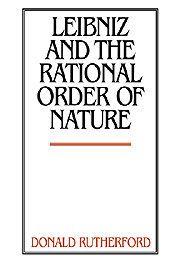Book contents
- Frontmatter
- Contents
- Acknowledgments
- A Note on Citations and Translations
- Abbreviations
- Introduction
- Part I Theodicy
- Part II First Philosophy
- Part III Nature
- 7 Modeling the Best of All Possible Worlds
- 8 Monads, Matter, and Organisms
- 9 Dynamics and the Reality of Matter
- 10 Corporeal Substance and the Union of Soul and Body
- Conclusion
- Bibliography
- Index
10 - Corporeal Substance and the Union of Soul and Body
Published online by Cambridge University Press: 05 June 2012
- Frontmatter
- Contents
- Acknowledgments
- A Note on Citations and Translations
- Abbreviations
- Introduction
- Part I Theodicy
- Part II First Philosophy
- Part III Nature
- 7 Modeling the Best of All Possible Worlds
- 8 Monads, Matter, and Organisms
- 9 Dynamics and the Reality of Matter
- 10 Corporeal Substance and the Union of Soul and Body
- Conclusion
- Bibliography
- Index
Summary
Although Leibniz's later metaphysics is dominated by his theory of monads, we have found that it also incorporates a complex set of views about the nature and structure of matter, including the thesis that matter is everywhere composed of an infinity of organic creatures. According to the interpretation advanced here, there is no inconsistency between this thesis and the claim that reality consists solely of monads, for we have seen that we may construe the panorganic structure of matter as a “result” of monads and their intrinsic modifications. Nevertheless, from the 1680s on, Leibniz shows signs of being drawn toward a more robust conception of the reality of organic creatures. Some authors have contended that he embraces such creatures as true corporeal substances. In writings from his middle period, it has been argued, Leibniz “recognizes two distinct and genuinely different varieties of substance”: soullike substances and corporeal substances, “forms or souls united to bodies, and understood on the model of living things.” Going this far, it has been only natural to see traces of this position – one recognizing the reality of corporeal substances – in Leibniz's later writings, even when it is clear that his primary conception of substance has stabilized around the notion of the monad.
I have already expressed some skepticism concerning this reading. In this chapter, I examine in a more systematic way the extent of Leibniz's commitment to corporeal substances. I propose to do this by focusing on his treatment of the union of soul and body.
- Type
- Chapter
- Information
- Leibniz and the Rational Order of Nature , pp. 265 - 288Publisher: Cambridge University PressPrint publication year: 1995



